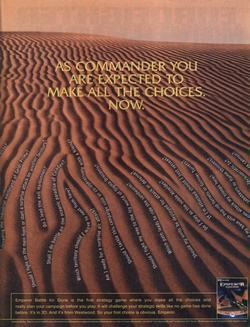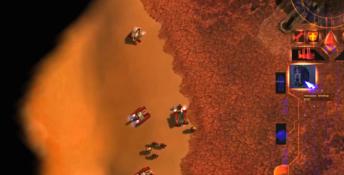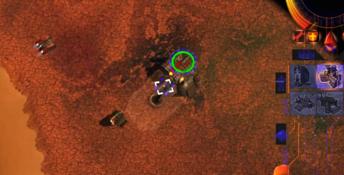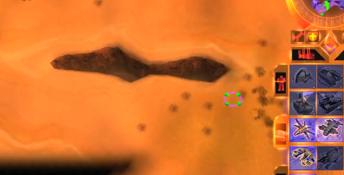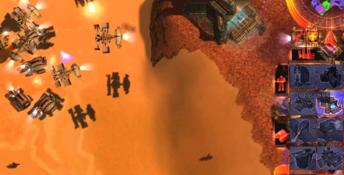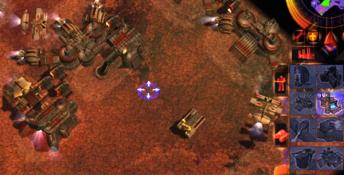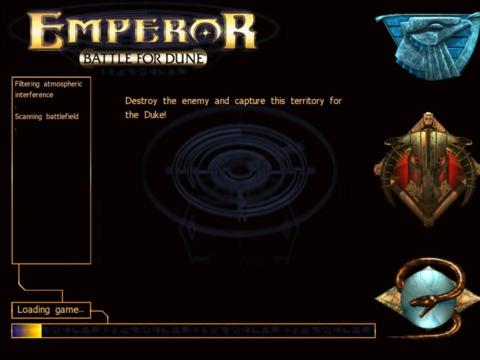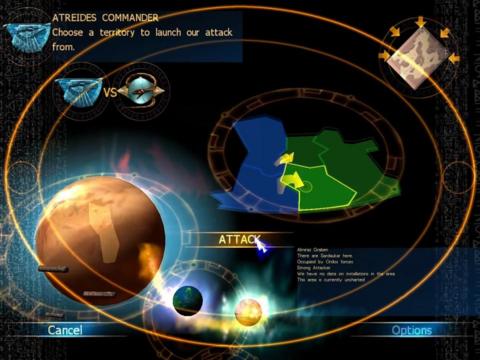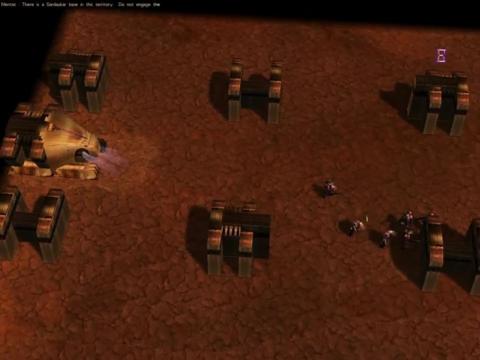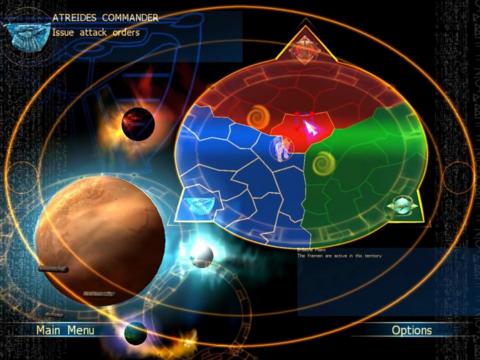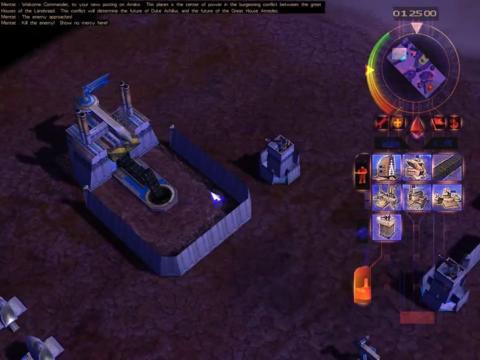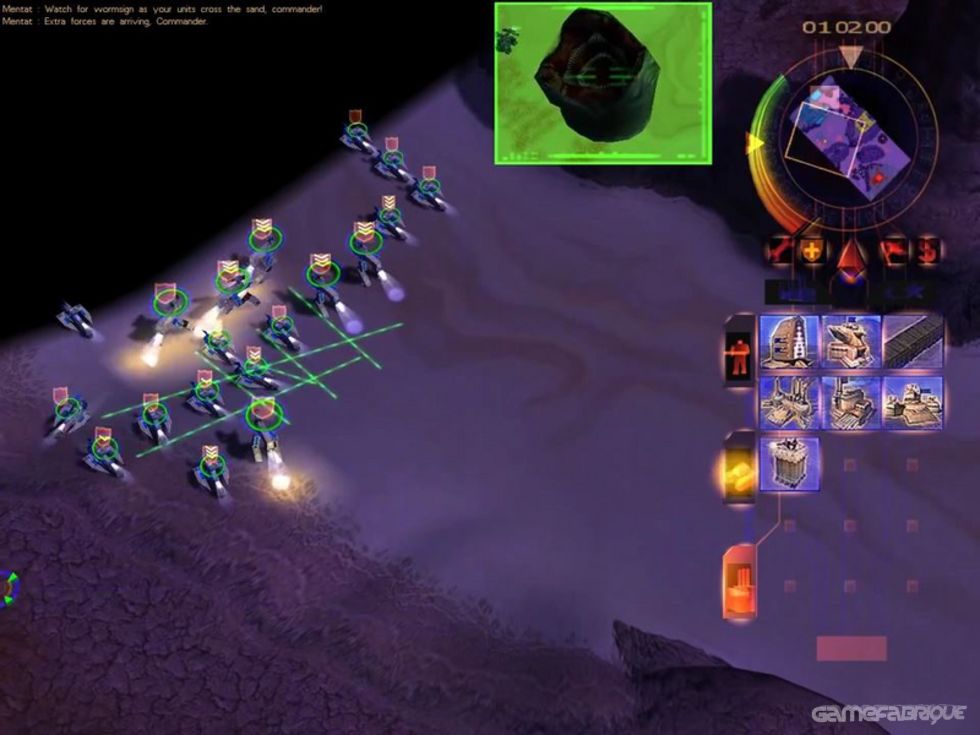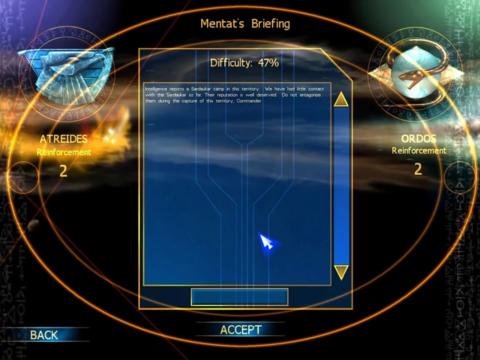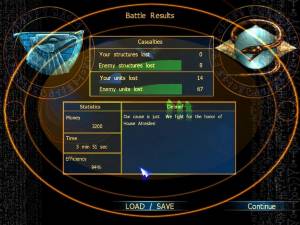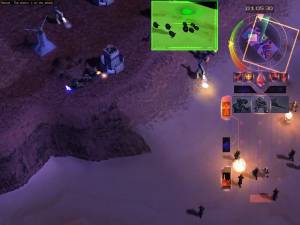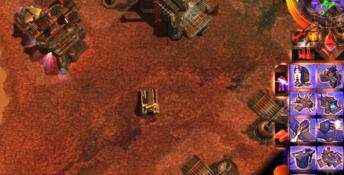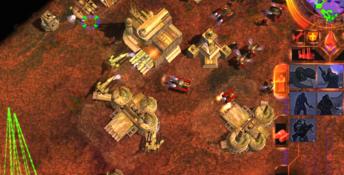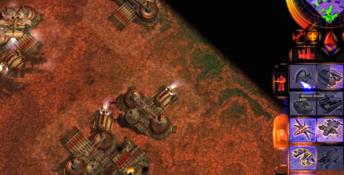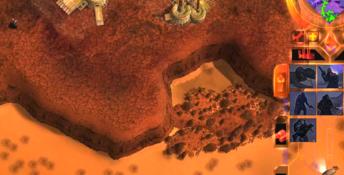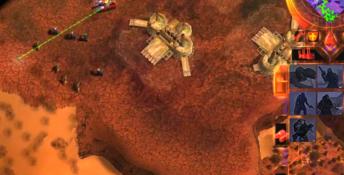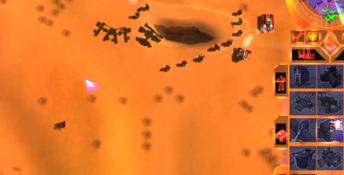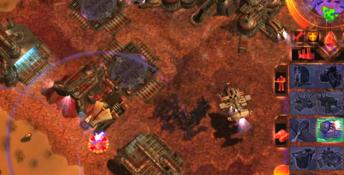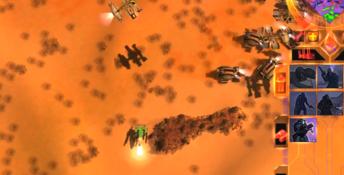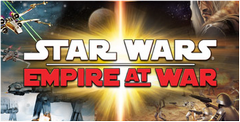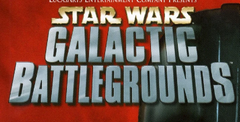Emperor: Battle for Dune

| a game by | Westwood |
| Genre: | Strategy/War |
| Platform: | PC |
| Editor Rating: | 8/10, based on 1 review, 4 reviews are shown |
| User Rating: | 8.0/10 - 22 votes |
| Rate this game: | |
| See also: | Download Strategy Games, 3D Games, Dune Games |
The war for universal supremacy will once again rage, and this time, it will happen in glorious 3D. Well, that's according to the opening line of the Westwood press release, anyway. Thus far, the pioneers of the RTS genre have resolutely stuck to their original 2D vision, while all around them have produced flashy 3D-accelerated affairs with multiple camera angles and lens flare ridden explosions. It's an approach that has yielded a number of undeniably great games, but unfortunately many developers have been so preoccupied with delivering the visuals that they overlooked the gameplay, churning out ultimately shallow graphical showpieces. But not Westwood. At risk of being labelled Luddites, they sat back and observed what the rest of the world was doing, while keeping the coffers topped up with the likes of Tiberian Sun (eventually) and the recent Red Alert 2. However, for the last two years, deep in a bunker in the Nevada desert (or a bland office on the outskirts of Las Vegas), a crack team has been secretly working on a game that will forever change the RTS landscape. That game is Emperor: Battle For Dune, and from the tantalising glimpse we were afforded, it seems vaguely all right.
Clearly, the shift to 3D represents a big decision for Westwood, although it is adamant that its hand hasn't been forced. Emperor producer, Chris Longpre, spoke exclusively to PC from the corner of a Moroccan restaurant in Las Vegas.
"Oddly enough, gamers and the press have been screaming for 3D RTS over the past year, and now that a few have been done, it seems the feeling is not as strong as before. We that just adding 3D to an RTS would lead to some problems, and not provide the fun gameplay that gamers truly desire. That is why we took our time to seriously consider how it was to be done, and how to ensure great gameplay. We feel that our take on 3D in an RTS is optimal for visual excellence and gameplay superiority."
He's not the first game producer to think that, and he won't be the last. In waiting this long to make the move into 3D though, Westwood has the benefit of hindsight. As Longpre says: "In the past we've resisted rushing into 3D because we didn't want to make the same mistakes of lots of the companies that did. We've all seen some of the other games that have embraced 3D without really thinking about how it affects gameplay. Devastating consequences." Steady.
Spinney-Rotatey
With this 3D advancement, Emperor will now feature the much-coveted spinny-rotatey camera view that many gamers felt was lacking from games such as Tiberian Sun. Again, this is riddled with pitfalls, but Longpre is confident that they will get it right.
"Other 3D RTS's have made the mistake of letting the camera go everywhere. From a marketing point of view it's very exciting to say 'Hey look! You can look over the guy's shoulder as he's shooting that bazooka!' But from a gameplay point of view there's really no point in doing it. What happens is the player gets confused, lost, disoriented, can't figure out how to get the camera back where it was, can't figure out which way is up, etc. So you have to be very careful how you handle that. The key thing you want to do with an RTS is you want to keep your point of view up in the sky where you can see lots of units at a time, and make a strategy."
From the cursory look we were given, it was difficult to see any discernible difference from the majority of 3D RTS camera systems, but we'll have to take his word for it. We can at least claim to have seen a Westwood RTS spin and rotate in front of our very eyes. And there aren't many people who can claim that (or indeed would ever want to).
We've established that Emperor is 3D-accelerated, and that it spins and flips like a drunken breakdancer. What about the minutiae of the actual game? Well for starters, it takes place within Westwood's somewhat modified version of the Dune universe. Some fans of the books have already been openly weeping about minor inconsistencies in the story, but might be better off channelling their efforts towards finding a girlfriend, or even just a friend. As Longpre says, "Our story takes place in the Dune Universe, prior to the events in the movie, but in roughly the same era of Arrakkis. We have developed the story ourselves with no intention of tying into any of the storylines in the Frank Herbert books, both old and new. Our story is separate, and suited to the game that we have created."
An Unholy Alliance
That game will feature three unique sides, namely the noble House Atreides, the evil Harkonnen and the insidious Ordos, each boasting bespoke units and buildings. Once a player chooses his main ally, he will then be able to form alliances with any two of five sub-houses, all with their own special weapons and benefits. The three homeworids are markedly different, namely the oceanic paradise of Caladan, the industrial wasteland of Geidi Prime, and the icy planet of Draconis. The main planet Arrakis is also split into numerous territories, which can be claimed and lost in battle. As Longpre says: "Something we really wanted to do design-wise was to allow the player to decide which territories he thinks are important, which ones to attack, which ones to defend and which ones to ignore completely.
Each territory has strengths and weaknesses. The main goal here was to get the sense of planetary conflict, epic in scale." As for the conflict, the weapons are predictably outlandish, including such treats as the lofty Kobra cannon and the lumbering Minotaurus tank. The battles will mainly be large-scale affairs though, as according to Longpre: "RTS fans are not really interested in playing a squad-level game. They want to be looking at a battlefield, commanding whole groups of troops, armies as it were. Looking at the defences of a base, figuring out 'How do I get my best units into the base, past that. I'll put my troopers here, my sonic tank there, and then when they come out I'm going to send in the engineers through the back door' strategy. And that's something we've tried really hard to emphasise is that diversity gives you lots of choices as a player, how you customise your army."
The Spice Of Life
All too often, real-time strategy games involve a host of generic units grinding each other down in a long-winded war of attrition. Westwood has taken steps to ensure this doesn't happen, and has concentrated on making the three main houses very different.
According to Longpre: "One of the big design goals that we had was to provide some really meaningful diversity in the sides and in the units. So, the Harkonnen are very evil, their whole unit selection really reflects their sort of attitude about how they treat warfare. They're very brutal. They don't mind wasting resources, wasting their troops or your troops. The Atreides are the noble warriors. They're the ones that are very loyal and will do anything that the Duke asks them to do. A little bit more precise, when they rake out something they just want to blow up the building they need to stop the production and win the war. And their units kind of reflect this general philosophy. The Ordos, which are treacherous and devious and insidious, they're the ones that have plans within plans, they're always manipulating something behind the scenes to get what they want. If you're a sneaky hit-and-run kind of player, Ordos are the way to go. They're also expert traders, and they trade with everybody in the galaxy, so they've got a lot of really strange technologies nobody's ever seen before."
And let's not forget the worms, which actually come in three sizes. However, before Chris can tell us about them, the cheesy game music segues into something more exotic and far louder, as a real live belly dancer begins to gyrate behind the monitor. Emperor might be a good-looking game, but there's simply no competition. And on that bombshell...
The Waiting Game
Out next year...
Westwood's policy of sometimes releasing games years after the original stated date has led to a degree of ribbing in the specialist press, not to mention tearful tantrums in games emporiums all over the world. However, if people don't know that a game is coming out then they can't really complain that it's lata Secrecy would appear to be Westwood's current strategy, as demonstrated by the swift announcement and subseguent release of Red Alert 2. A similar tack has been taken with Emperor, whose producer admits "It's one of the best kept secrets we've had. We're always striving to do better and better about shipping games on tima It's also important not to release all the information early because you're planning on it coming out on tima Tiberian Sun, if it had come out when we originally intended it to, it would have been just fina We think this is just the right time to announce Emperor."
As for a release date? "Some time next year. Whenever it's done. It'll be out definitely before Christmas next year, 2001."
So if you're still drumming your fingers in two years' time, don't shoot the messenger.
The Houses Of Dune
Not one, not two, but three different sides to choose from. Westwood sure knows how to spoil a bloke...
Atreides
This honourable house from Caladan employs unlikely methods in its struggle to secure Arrakis: noble spirit, iust ways and unfailing virtue Ruling its homeworld for ten generations with justice and generosity, House Atreides has perfected a form of government that results in a well-organised society and a spiritually satisfied people
Harkonnen
Hailing from an industrial wasteland of a planet called Giedi Prime, House Harkonnen is built on a simple foundation of fear and tenor, two tactics that make the Baron Harkonnen's troops that much more dangerous.
With an order based on treachery, soldiers rise through the ranks through deceit, trickery and, if necessary, assassination.
Ordos
These aristocrats are shrouded in mystery and speculation, which is just how the statesmen of Ordos want to keep it. Run by a secretive cartel of the rich and powerful who specialise in trade and smuggling, House Ordos has no identifiable leader. Even the citizens on the ice-coated, remote planet of Sigma Draconis have little grasp on who controls their fate.
Download Emperor: Battle for Dune

System requirements:
- PC compatible
- Operating systems: Windows 10/Windows 8/Windows 7/2000/Vista/WinXP
Game Reviews
One of the few things we managed to agree on during our Most Influential Games Supertest was that Westwood's Dune 2 was the pioneering force behind RTS games. In fact, Dune has become a phenomenon in the gaming world simply because the games have become more firmly entrenched in people's minds than the film, if not even the original books.
Believe it or not, there was gaming life before Dune 2- Cryo Interactive's unsurprisingly titled Dune was released in 1992. I'm probably the only person left in the country who remembers that game fondly, in particular because it allowed you to do a spot of worm riding, something I'm glad to report is in the new spinny 3D remix. Although shamelessly eclipsed by the second Dune title, the original adequately established that there was a market for Frank Herbert's spice-drenched world on the small screen. Now, thank god, Dune has gone 3D and, let's face it, Dune 2000 isn't going to keep things chugging along for much longer. Due for release this June, Emperor Battle For Dune looks set to become another impressive notch in Westwood's RTS bedpost. But will it deliver the much-needed injection of inspiration into the Dune world?
When you need the answer to that sort of question, you don't speak to the monkey, you need the organ grinder.
Why have you waited this long to move into 3D, and why did you decide now is the right time?
We decided we didn't want to use 3D for the sake of 3D; we wanted to use it to enhance gameplay and add beauty and depth to the environments. The diversity of the characters and environments make Emperor the perfect setting for an RTS. Also, we felt that the technology had finally advanced far enough and was accessible enough to the masses that we coul use effectively.
What new innovations, apart from 3D, does Emperor bring to Dune?
We're adding whole new levels of strategy and tactics that haven't been seen before in an RTS game, primarily using our non-linear campaign map. Rather than progressing through a static number of pre-defined missions, the player has to pick and choose which territories to attack based on the available information. Do I have any reinforcements for previously conquered territories? What is the strength of my enemies in the nearby areas? Can I gain any allies if 1 move into this territory? All these questions must be answered before deciding how to proceed.
Also, we allow the player to customise his army like never before. Along with choosing one of three houses to play, each with unique and diverse units, the player will be able to form alliances as the campaign progresses. The player can ally with up to two of the five sub-houses, and doing so will give them access to those houses' technologies and units. This makes the number of meaningful combinations of units very high and we expect people will debate the best combination for some time.
What elements have you kept from Dune 2 and Dune 2000 and why?
We've tried to stay true to the overall theme of the Dune universe so that fans of Frank Herbert's Dune and Dune 2 will immediately feel at home with the game. And although we are expanding on our traditional RTS model, we believe die-hard RTS fans, along with newcomers to the genre, will have a lot of fun with the game.
Why did you choose to follow an independent storyline, rather than use characters from the books?
We wanted to create our own unique storyline, but still stay true to the feel of the Dune world so we can appeal to everyone - fans of Dune, fans of Command & Conquer, and newcomers as well. We felt that if we followed the original story too closely, we might alienate people who are not that familiar with the characters and plot.
Most under-18s won't be too familiar with David Lynch's film or Frank Herbert's books. How have you kept the Dune universe fresh?
The universe is enormous and open to interpretation, which is why we've seen so many different stories emerge from the original book. Characters evolve and branch off from the original story; new political intrigues surface and must be resolved. Stories can be tailored to the interests of new generations of gamers.
Why do you think the Dune universe is so appealing?
The beautiful, lush worlds, the amazing and unique characters and the intriguing storylines all lend themselves to many stories and many ways to tell those stories. That's why the Dune universe has remained a phenomenon for more than 35 years and has been retold in print, movies, TV, online and in games.
In the case of each house, do you play as an established character or along the lines of a new general working his/her way up?
Regardless of the house that the player chooses, he will begin as the new commander for that side and be in charge of its entire armed forces. Although the player will follow the individual stories and political machinations that arise during the campaign, he will begin and remain the house's commander, in charge of all that goes on in the battle. That was really the only way we could involve the player in the story - he must be in charge of the battle from the start.
You've used an engine custom-designed especially for Emperor. How has this enhanced the game and do you intend to use it for future upgrades/games?
Many technical issues, such as sand and rock visualisation and camera movement, are specific to Emperor: Battle For Dune and we came up with unique solutions for each of them when designing the game's engine.
From the beginning, our main goal in using 3D technology was that it would serve to enhance gameplay. The engine not only adds beauty and depth to the game, but it's used in a way that will better allow the player to control the battle. The player will be able to control the camera to his benefit (zooming in and out, rotating the battlefield), but the camera movements will never become difficult to manoeuvre.
Using real actors for cut scenes can sometimes be a bit hit and miss. What made you decide to do this and what do you think it adds to the game?
Westwood has a tradition of using high-quality cut scenes to advance the stories, and Emperor will be no different. We've hired top Hollywood talent to portray our characters -including Michael Dorn from Star Trek as Duke Achillus; Mike McShane from Who's Line Is It Anyway? as Baron Rakan Harkonnen; and Vincent Schiavelli as the Harkonnen Mentat. We were amazed at how they brought these characters to life and added to the interactive experience we are trying to give the players.
What elements has Emperor: Battle For Dune borrowed from other Westwood titles?
Westwood pioneered the RTS genre eight years ago with the release of Dune 2. Since then, we have continued to build on our tradition of creating interactive and fun RTS games with successive Dune games and the C&C series. Emperor is a true RTS game - those familiar with Dune and C&C games will feel right at home with it, while newcomers to the genre will be able to pick it up with minimal effort. That's another element we're bringing to Emperor: gameplay for all skill levels.
How will resource gathering be managed when not on Dune?
Melange is the only resource in the game that can be used as currency, and it is only found on Arrakis Dune. When the battle moves to the other planets - the lush, green Caladan; the industrial wasteland of Geidi Prime; and the ice world, Draconis IV - the players will receive regular money'shipments' to keep up production.
This adds an interesting layer of strategy to Emperor, in that it forces the player to truly manage his resources for building units and structures.
How many units will you be able to control at once?
The only limit to how many units the player can build and manage is how much money he has. We are allowing the player to queue up 99 units for construction and he will be able to do that until his money runs out.
How will you incorporate combat shifts between Dune and the home planets of the three main houses in the storyline?
The main campaign will be fought on Arrakis, otherwise known as Dune. Controlling this planet and the spice is the key to victory. For that reason, it is necessary to capture all the territories before the battle moves to the homeworlds. Only when the player has driven the enemy back to its homeworld and defeated them will he be able to claim victory.
How will the concept of folding space (basically, hyperspace travel using spice) be incorporated?
Folding space allows the Guild to transport Heighliners across great distances, delivering cargo and even other ships. A local form of space folding is used in the game by the Guild NIAB tanks. They can effectively teleport themselves around the battle map for a surprise attack.
Could you tell us more about the five sub-houses you can ally with? Can you ally with more than one? And can you break alliances?
The player will be able to ally with up to two of the five sub-houses during the single-player campaign. This is by no means necessary to complete the game, but forming alliances will give the player access to additional units and structures, allowing him to fully customise his army. The sub-houses include the native Fremen warriors, the Imperial Sardaukar soldiers, the tech-weapondealing lx, the bioengineering Tleixu and the spacer's Guild.
Each of the houses has its own secret weapon. Can you tell us about how these will be used within the gameplay?
Each house has a super weapon, similar to the nuke or weather storm in Red Alert 2 - incredibly powerful and only available once the player has progressed to the top of the tech tree. The Harkonnen Death-Hand missile makes a glorious and brutal return. The Atreides can terrorise and demoralise their enemies with the Hawk Strike. And an Ordos twist on mind control, Chaos Lightning, throws your troops into a berserk rage, killing anything in sight... even each other.
How have you enhanced unit AI?
We designed the AI with the goal of making it feel like you're playing against a real person, with all the uncertainty, surprise factors'tffid various game strategies. Therefore, we developed a complex system that teaches the AI about map features and player strategies. When a mission starts, the AI knows nothing about the map it cannot see, and will usually start a scout mission to push back the shroud and keep the fog-of-war away. After that, it uses the war strategies of the house it is playing to defend its base and start an offence. The AI is aware of unit positions it can see and will plan accordingly. It's good at finding your weakest link and hitting it - hard.
Controlling camera angles can often be very problematic in 3D games. How have you dealt with this potential problem?
Camera controls have often been a bane to 3D RTS games in the past because they allow the player too much freedom. The player may zoom in too close or too far away, and not e able to get back to a playable position. On the other hand, if you don't give the player enough control, it's almost pointless to have a moveable camera. We think we've found a good balance in Emperor. We give the player the ability to zoom in and out and rotate the battlefield, while still limiting movements to the extent that they don't become cumbersome or difficult to manoeuvre.
How have you used the sandworms in Emperor, and will we get a 3D riding session?
There are actually two kinds of sandworm on the planet Dune: the small worms that the native Fremen can control, along with giant, destructive worms that can devour an entire army. If you ally with the Fremen, you will be able to train Fremen Fedaykin warriors. If a small sandworm turns up, the Fremen Fedaykin warriorwill ride the worm and go on a unit-gobbling spree. After a couple of units, the worm becomes full and descends under the dunes once more, and the Fremen dies a glorious death. As for the giant Shai-Halud worms, they are indestructible; your only defence against them is to not attract their attention. Any movement atop the dunes will tempt worms, but heavy equipment and shields are absolute magnets! Fortunately, the computer informs the player when a large sandworm is in the area and the player will be able to visually track their movement on the map.
When is the game going to be released?
Emperor will be released this summer.
Have you got any plans to expand into similar/other genres with the Dune universe?
Only time will tell...
In 1993 the iconoclastic Westwood Studios releasedDune 2 It had an instant and profound effect on the game-playing public. Almost overnight, healthy, young men became edgy, nervous hermits surviving on nothing but a torrid diet of harvesting, refining and constructing. This phenomenon later became known as the 'RTS', and from its loins leapt the illustrious likes of Command S Conquer, Red Alert, Tiberian Sun and Red Alert 2.
Another less impressive ottering from the same developer was Dune 2000. This piss-poor remake of Done 2 made no new friends, indeed some old friends claimed it was identical to Dune 2 but with updated graphics. Well, the truth must have hurt because with Emperor: Battle For Dune, Westwood has tried yet again to bring the game that started it all bang up to date.
Scary Spice
We emphasise the word 'tried' because sadly it appears that Westwood Studios has again missed its mark. Why? Well, to put it kindly, the much-vaunted 3D engine needs some work. No, let's rephrase that - it needs to be stripped down and totally rebuilt. If this engine was inside a brand new Formula One racing car, the Ferrari, McLaren and Williams mechanics would be leaning over the pit wall pointing and pissing themselves with laughter.
For a more relevant comparison, let's just say that there isn't a single leading RTS game on the market that need worry about the graphical capabilities of Emperor. There is no option to zoom right down into the action like in Ground Controt there is no real-time day/night cycle like In The Moon Project, and the textures on everything from the landscapes to the units are very garish indeed. In fact the last time we saw colours clash this bad was on Pyjamarama for the Spectrum 48K. And it's not just the textures that are dire. Most units and buildings are made up from extremely basic polygons giving the game a pronounced blocky look. With this in mind it actually makes sense that you can't zoom in too close, because if you did you'd recoil in horror at the mess before you.
Aesthetically, the only part of the game that's remarkable is the musical score and sound effects. In fact, if this review was based on those two elements alone Emperor woM receive in the region of 100 per cent. Pity then that this magazine is not the NME and our reviews are based upon a game's ability to entertain.
Let Me Entertain You
Traditionally this is where Westwood has always excelled. But again, on this occasion there appears to be little imagination on the developer's part. The game experience itself is virtually identical to every other RTS game Westwood has released over the last decade or so, though notably it lacks the satirical humour so prevalent in Red Alert 2.
Firstly we get to choose from three different sides. OK, so it's always nice to have a choice and we're very grateful for it, but after extensive play you realise that apart from the poorly acted FMV sequences and the way the story unfolds, there's really no significant difference between the protagonists. It doesn't matter whether you play as House Atreides, Harkonnen or Ordos -it's the same three-point plan to success. The same old strategies are present in so far as you get your main base up and running, start collecting your resources, and then you produce units. It's like listening to a CD on repeat for eight years...
Exactly how long can this go on for? Precisely how many more times will Westwood remix the same game and callously flog it for 30 quid? Come on guys... Innovate! You've done it before and you can do it again, and as the saying goes: "Nothing is more dangerous than an idea, when you have only one idea."
But the really disappointing part of all of this is that no matter how uninspiring this game is, people will still go out and buy it. Brand loyalty counts for a lot, and we have absolutely no doubt that Emperor go straight to number one. A lot of gamers simply don't have the time or patience to try anything else -they just stick to what they know. It's like when every single Metallica fan in the country pre-orders a new single and suddenly there's a guy on Top Of The Pops growling about nuclear holocausts and anthrax. There really is no accounting for taste.
The Best Laid Plans
You may have gathered that we're not too happy, and you'd be right. We've come to expect more from Westwood and the sad truth is that this game is not a classic. There are, however, certain areas that are worthy of praise.
The tactical overview map of Arrakis is an excellent idea and gives the player the chance to shift troops around the surface of the planet before selecting which sector to attack next. Players are also given data such as the intelligence of enemy AI as well as the amount of enemy and allied reinforcements available in each sector. It's a minor gimmick, but it's surprising how much this information affects your all-conquering plan.
Those with an adventurous disposition will also be pleased to learn that the action is not just confined to the vast deserts of Arrakis. There are numerous missions based on other planets in the universe that thankfully add much-needed graphical and strategic variety to the game.
Due to the lack of spice (or Melange to the cultists) on these other planets, a whole new approach is needed. In order to manufacture units you must ensure that there is a healthy economy back on Arrakis to meet the demands of your military spending. Providing the economic infrastructure is in place you are given regular shipments of cash to use as you wish. Alternatively you can create units and buildings in giant spaceports and have them delivered to the planet's surface. The only catch here is that you have to build the spaceport first.
There are also other subtler missions along the lines of Tiberian Sun and Red Alert where there are only one or two units to control. One example is where you have to take a small group of snipers into a space station and rescue some hijacked frigates. These missions come across as welcome respite where it's stealth and dirty tactics all the way. All of a sudden the gameplay is transformed into something much more joyous.
Oh, and lest we forget, back on Arrakis there are also bloody huge worms to avoid. Now when we say huge we mean massive. In fact these worms are probably one of Emperor's most atmospheric and faithful features. In the film you always get the impression that these creatures are the true masters of Arrakis and here it's no different. If you don't keep your eye on the desert and watch out for the telltale signs, you could find entire armies being swallowed whole. Worms aren't the only nuisances either; lethal sandstorms appear out of nowhere and suck your men into oblivion. In fact, there's more sucking and swallowing in this game than in a Thai massage parlour.
Who's In The House?
But there is one particular gameplay aspect in all of this that stands proud and drags the game way above the average, and that is your ability to form treaties and alliances with lesser-known subhouses of Arrakis. By allying with someone such as the Fremen or the lx (to name two of the five in total), the player gets to build a camp for that house within their base. This allows access to more troops and more military units with new special abilities, as well as occasional reinforcements from that house.
In the single-player campaign this wider variety of units doesn't necessarily change the overall battle strategy that much, but what it does do is offer the player a few more RPG-type choices along the way. In multiplayer skirmish matches however, this option really comes into its own. Imagine, if you will, four players each playing as House Harkonnen. Traditionally you would be safe in the knowledge that all your opponents have the same weapons and the same abilities as you. In Emperor you now get the choice to select the sub-house you are allied with before the start of the game, thus adding a new variable to the equation. Theoretically each person on that map could have a different sub-house ally, with nobody knowing who that ally is until the first attack. Ultimately it add mystery to the skirmish and thus makes the tactics and the game's outcome far less predictable than usual.
Despite its many shortcomings in other areas, there's no denying the multiplayer side of Emperror is a technical step forward from anything they've done before, and there's no question that it advances the gamepiay significantly. If you want a long-lasting multiplayer game with great options and a plethora of units and tactics, you could do a lot worse. In fact, we recommend it - providing you can forgive the graphical dog's dinner, of course...
Must Try Harder
Earlier we mentioned how other real-time strategy games had nothing to worry about when it came to the graphics engine in Emperor. Unfortunately, pretty much the same can be said for the gameplay. On the one hand, it's too simplistic to attract fans of games like Earth 2150 and The Moon Project. Conversely, the tiresome harvesting and refining concept is too fiddly and old-skool for those who've defected over to the more straightforward approach of Ground Control anti Steel Soldiers.
There truly is only one type of games player who will appreciate the limited appeal of Emperor and that is the devout Westwood groupie. For them Emperor contains all the right ingredients: the instantly recognisable resource management interface, the cheesy FMV acting, the ability to play as one of three sides, and the 3D engine fans have been screaming for. Oh yes, if you've survived on the Westwood diet for the last few years, you'll quickly forgive the prototype engine and appreciate Emperor lor what it really is - more new levels for Tiberian Sun and a few more units to boot. Hurrah.
For the rest of us though, it's simply impossible to get overly excited about. We had high hopes for the game, as everyone did, but we can't help feeling a little let down.
We know there will be heated disagreement from many quarters, but if those responsible for Emperor are honest with themselves, they must know in their hearts that there is much, much better to come.
Overview
Emperor: Battle for Dune is a follow-up to Dune II, which is widely considered to be the first RTS game. This installment follows the struggle of the three "Great Houses" of Atreides, Harkonnen and Ordos to control the planet Arrakis, also known as Dune. The storyline borrows from both the literary and feature film versions of the Dune story for the world setting and general feel of the plot.
The story begins following the assassination of the reigning Emperor. Prior to his death, the Emperor had set in motion a great war for control of the governorship of Arrakis, in the hope that the great Houses would destroy each other and thus eliminate all competition for his position. The three Houses now compete for the Emperor's vacant position. The prize will go to the House capable of controlling the most territory and thus the spice Melange, which exists only on Arrakis; the spice is the secret to extended life, space travel and other such things.
Gameplay, Controls, Interface
Gameplay is pretty typical RTS fare. The majority of gameplay revolves around building a base, defending the base, collecting resources, building troops, finding and killing the enemy. A few of the missions include objectives such as rescuing a lost commander, but most are typical "destroy the enemy and take over his territory" type missions.
In the single-player mode, you may choose either a single skirmish battle in a variety of game locations, or campaign mode in easy, medium or hard difficulty settings. You may play as any of the three Houses, and the storylines and units vary somewhat depending on the chosen House.
One place where Battle for Dune does differ from many RTS games is that it offers some degree of non-linearity in the campaign mode. You are presented with a simple Risk-like map that represents the territory controlled by the various factions. You may choose one of several different territories, which represent various phases of the campaign, to pursue. Unfortunately, there are usually only two or three choices at a time, so the game is still fairly linear.
Another interesting gameplay feature is that you may choose to form alliances with various sub-Houses, such as the Fremen warriors made famous in the Dune movie. These alliances allow for the construction of special units unique to the sub-House with which your House has allied. Attacks from the invincible Sand Worms and sandstorms that can damage your units and buildings provide additional obstacles to victory for both sides.
The interface is fairly straightforward. You are presented with an on-screen button menu; click to select functions such as constructing buildings, training new infantry, repairing or selling buildings, and setting patrol routes. A radar screen is also provided for viewing the game map and maneuvering over large distances.
Collecting spice is the only real resource-gathering event in this game and is more or less automated once you have constructed a refinery. The menu buttons make base construction a snap. Controlling your troops can prove to be a more difficult and often frustrating experience.
While both the mouse and keyboard shortcuts provide some means of "grouping" various units together, it is still difficult to get your troops to function well as a team. They will often run into each other and just stop, and you must go back and manually move troops around to get them where they are going. I also found it difficult to move individual units into good attacking and defending positions quickly enough to be of any benefit in the generally fast-paced battles.
Both enemy and unit AI leave something to be desired. Units will often ignore height advantages, walk right into enemy gun turret fire, and get run over by vehicles when they could easily avoid these situations. Getting your troops to behave in a semi-intelligent manner when attacking or defending requires a large amount of tedious micro-managing.
Multiplayer Support
The game provides support for up to 4 players via LAN or Westwood Online's matching service for skirmish and deathmatches. You can customize the amount of money, starting equipment and various other features or even set up your own custom match. Two players may also elect to play a co-op campaign, in which both players are given units and may work together to accomplish campaign goals.
The matching service is fairly speedy and lag wasn't much of a problem when I played. The skirmishes and deathmatches were more interesting than playing a skirmish against computer AI, but I found myself getting bored with them fairly quickly. I enjoyed the two-player co-op mode more than the skirmish mode, though it also failed to capture my interest.
Graphics
Battle for Dune is set in a fully 3D environment. The buildings and units look pretty good, but the terrain is uniformly blah. Although battles take place in environments as diverse as a desert, a water world and an ice-covered planet, the only real difference in the look of the terrain is the color. The buildings and infantry units suffer from too much similarity as well. The Harkonnen troops are usually easy to pick out because of their red color, but the colors of the Atreides and Ordos troops are very similar and it can be easy to mix up which infantry belongs to which side. The cut-scene movies benefit from very high production values and resemble the feature film Dune. However, they do suffer from some amount of graininess and overacting. Overall, the graphics don't hinder gameplay that much, but they don't do much to enhance it either.
Audio
The audio for the game is very nice. The game includes a variety of digitized speech that ranges from updates on the status of reinforcements to mission objectives to interesting, sometimes amusing quips from the various units in your army. Westwood did a good job of giving the various units distinct personality through their lines when you select them or give them a command. The music has a nice sci-fi movie score sound to it. The sound effects from the vehicles, units, and other special effects are all fairly convincing.
System Requirements
Pentium II 400 MHz or faster processor, Windows 95/98/2000, 64 MB RAM, 700 MB hard disk space, 4X CD-ROM drive, 16 MB video card, DirectSound-compliant sound card, 3D hardware accelerator
Originality/Cool Features
Unfortunately, Emperor: Battle for Dune doesn't rank high on the originality front. The game has a very old-school RTS feel to it and while it incorporates some interesting ideas, it doesn't do much with them. The Dune-flavored units and obstacles add something different to the game world, but overall the game feels more like Command and Conquer in Dune clothing than an entirely new game.
Bottom Line
Fans of "classic" RTS gameplay and the Dune books/movie will probably enjoy this game. Westwood doesn't do much that is new with the RTS formula, but they don't really do anything to screw it up either. For those looking to move beyond standard RTS gameplay, this is not the place to look. While Emperor: Battle for Dune has no glaring problems, it also has no standout features to separate it from every other RTS game out there.
I found myself getting bored with this game fairly quickly. The battles can be tedious. The cut-scenes are often silly and almost always over-acted, and as you move deeper into the game they taper off rather than building up to a big finale. The replay value is diminished by the fact that even on the hardest setting the game is more frustrating than challenging, and the Houses do not differ enough from each other to justify playing the campaign again as a different House.
The bottom line: The story is ok. The graphics are ok. The interface is ok. The game is ok. However, there is nothing about Emperor: Battle for Dune that will make the average player sit up and go "wow." To paraphrase a friend of mine, it didn't suck, but it didn't knock my socks off either.
